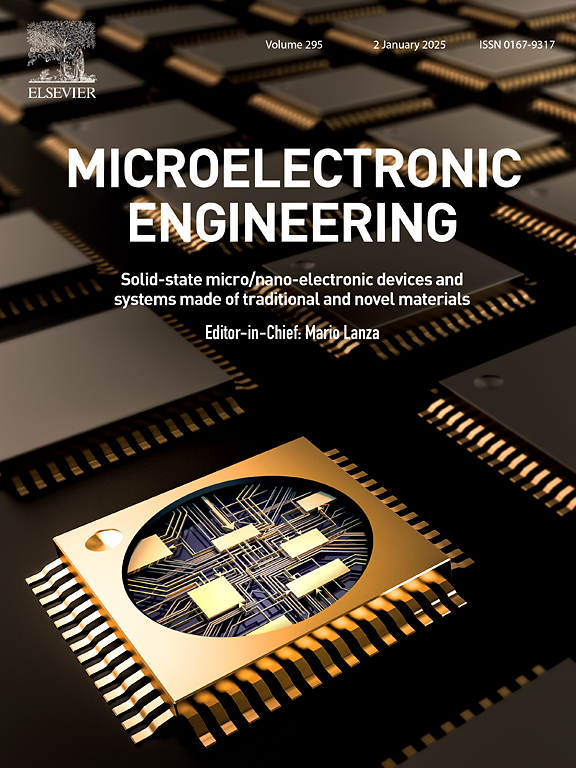Unveiling strain in future generation transistor technology by Bessel beam electron diffraction method
IF 3.1
4区 工程技术
Q2 ENGINEERING, ELECTRICAL & ELECTRONIC
引用次数: 0
Abstract
Strain engineering is a common approach for enhancing the mobility of semiconductor materials and improving the performance of conventional and novel transistors. Understanding the strain distribution is important for optimizing device characteristics. Transmission electron microscopy (TEM) is a crucial technique for evaluating strain at the nanoscale. However, due to the ongoing reduction in electronic device dimensions, assessing strain via TEM has become increasingly challenging. Many different techniques have been developed in recent years with the aim of analysing complex structures. In this work, we investigate the capabilities of the recently developed Bessel beam electron diffraction (BBED) method to evaluate strain by TEM in fully processed fin-field effect transistor (FinFET) devices and in cutting edge nano-sheet complementary-FET (NS-CFET) technology.
TEM analysis of fully processed devices is challenging due to the presence of artefacts generated by different materials and multiple structures overlapping in projection in TEM images. We demonstrate the capability of the BBED technique to reveal strain in fully processed FinFET while exploring the dependence of strain on layout variations.
NS-CFETs are an attractive device architecture for beyond 1 nm logic technology nodes. Strain distribution in these devices is more complex than in FinFETs due to the presence of very thin layers and reduced channel dimensions. We compare the BBED method with the well-known techniques of nano-beam electron diffraction (NBED) and geometric phase analysis (GPA) for analysing strain in these structures. The BBED technique, despite a simple experimental setup, shows good accuracy and spatial resolution, being able to resolve interlayers thinner than 2 nm. Compared to NBED and GPA, the BBED technique offers better performance and is therefore a promising method to study strain in future transistor devices.

贝塞尔束电子衍射法揭示新一代晶体管技术中的应变
应变工程是提高半导体材料迁移率和改善传统和新型晶体管性能的常用方法。了解应变分布对于优化器件特性非常重要。透射电子显微镜(TEM)是评价纳米尺度应变的关键技术。然而,由于电子器件尺寸的不断减小,通过TEM评估应变变得越来越具有挑战性。为了分析复杂结构,近年来发展了许多不同的技术。在这项工作中,我们研究了最近开发的贝塞尔束电子衍射(bb)方法在全加工fin-field效应晶体管(FinFET)器件和尖端纳米片互补fet (NS-CFET)技术中通过TEM评估应变的能力。由于在TEM图像中存在由不同材料和多个结构重叠投影产生的伪影,因此对完全处理的器件进行TEM分析具有挑战性。我们展示了在完全加工的FinFET中显示应变的能力,同时探索了应变对布局变化的依赖性。ns - cfet是一种具有吸引力的器件架构,适用于超过1nm的逻辑技术节点。由于存在非常薄的层和减小的通道尺寸,这些器件中的应变分布比finfet中的应变分布更复杂。我们将此方法与众所周知的纳米束电子衍射(NBED)和几何相分析(GPA)技术进行了比较,以分析这些结构中的应变。尽管实验设置简单,但该技术显示出良好的精度和空间分辨率,能够分辨厚度小于2nm的夹层。与NBED和GPA相比,该技术提供了更好的性能,因此是研究未来晶体管器件应变的一种很有前途的方法。
本文章由计算机程序翻译,如有差异,请以英文原文为准。
求助全文
约1分钟内获得全文
求助全文
来源期刊

Microelectronic Engineering
工程技术-工程:电子与电气
CiteScore
5.30
自引率
4.30%
发文量
131
审稿时长
29 days
期刊介绍:
Microelectronic Engineering is the premier nanoprocessing, and nanotechnology journal focusing on fabrication of electronic, photonic, bioelectronic, electromechanic and fluidic devices and systems, and their applications in the broad areas of electronics, photonics, energy, life sciences, and environment. It covers also the expanding interdisciplinary field of "more than Moore" and "beyond Moore" integrated nanoelectronics / photonics and micro-/nano-/bio-systems. Through its unique mixture of peer-reviewed articles, reviews, accelerated publications, short and Technical notes, and the latest research news on key developments, Microelectronic Engineering provides comprehensive coverage of this exciting, interdisciplinary and dynamic new field for researchers in academia and professionals in industry.
 求助内容:
求助内容: 应助结果提醒方式:
应助结果提醒方式:


